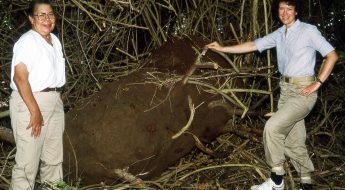Uncovering the “Fish Lizard”: Ichthyosaurs and Home
When the fossils of extinct species were first discovered, they were often misidentified. Case in point: Ichthyosaurs.
The first probable illustrations of ichthyosaur fossils were published by Edward Lhuyd in his Lithophylacii Brittannici Ichnographia, 1699. He attributed the fossils to fish. In 1708, Swiss naturalist Johann Jakob Scheuchzer attributed two ichthyosaur vertebrae to a man who drowned during the Biblical flood. In 1783, an ichthyosaur jaw with teeth was exhibited by the Society for Promoting Natural History as those of a crocodilian. In 1804, Edward Donovan discovered a four metres long ichthyosaur specimen that he described as a giant lizard.
Sometime between 1809-11, a young boy named Joseph Anning spotted a “crocodile” skull in the cliffs near his home in the seaside community of Lyme Regis, England. His sister, Mary Anning, excavated the skull from the rock and, a year later, also uncovered the torso of the same specimen. Mary would go on to discover many incredibly important fossils throughout her lifetime.
The Anning specimen was sold and later acquired by the British Museum. British surgeon Sir Everard Home was intrigued by the specimen, and, in 1814, published a description of it in the Philosophical Transactions of the Royal Society of London. This article would later be recognized as the first scientific publication dedicated to an ichthyosaurus. Home believed the specimen was more closely related to fish than any other group, although he expressed some doubts, as several aspects of it resembled reptiles. He concluded that it represented a transitional form between fish and crocodiles, exhibiting, like the platypus, he argued, traits of many different groups.
In 1817, German naturalist Karl Dietrich Eberhard König referred to the specimen as Ichthyosaurus, or “fish saurian.” Although he would not publish this name until 1825 (in his Icones fossilium sectiles), and despite the fact that in 1819 Home proposed the formal generic name of Proteosaurus in a scientific publication, other naturalists such as William Conybeare and Henry Thomas De la Beche adopted the name Ichthyosaurus in their own publications. By the standards of nomenclature, Home’s name should have priority, as it was published first, but the prevalent use of the name Ichthyosaurus consigned Proteosaurus to a status of “forgotten” nomen oblitum.
Today, we use the order Ichthyosauria, which was proposed by Henri Marie Ducrotay de Blainville in 1835, to describe over fifty valid genera of marine reptiles that flourished during the Mesozoic era and went extinct in the Late Cretaceous.
Fossil Stories
Stay tuned all week for more great fossil fun with our #FossilStories campaign, including:
- Tweets and Facebook Posts
- Blog Posts highlighting milestones and key publications in the history of fossil research
- A Flickr Collection with hundreds of historic fossil illustrations
- A Pinterest Collection featuring a selection of our favorite fossil illustrations
- A BHL Collection containing seminal publications in the history of paleontology
- A series of live webcasts at BHL partner institutions
- A citizen science challenge in collaboration with The Field Book Project, the Smithsonian Transcription Center, and Smithsonian Institution Archives







Leave a Comment